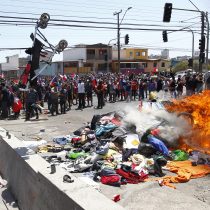
Predictably, the rhetoric of hatred and criminalization against immigrants has reached Chile. Being a usual resource of the right, both in Europe and in the United States, it was only a matter of time before our local right assumed the same discourse that is usually awarded electorally in other latitudes. Although it is not the first time that it is a question of installing this type of arguments, the statements of President Sebastián Piñera, who has affirmed that immigration matters crime and that “many of the criminal gangs are foreigners”, exceeded all the discursive limits that to date had been registered in the political field. Far from addressing in a reflective way the innumerable dilemmas and complexities that migration implies, Piñera opted for the reductionist letter, which awakens the most dangerous sensibilities and behaviors.
Following René Girard, the criminalization of immigrants generates a social dynamic of violence that is explained under the logic of “mimesis” or social imitation. Mimetic desire, as a hidden engine of culture, drives in societies a propensity to conflict, while human beings tend to take as a model what others value: goods, couple or fortune. Girard calls this longing the “mimetic rivalry,” a propensity that generates individual and social imbalances due to the inevitable frustration created by these unfullaimed desires. But this frustration, which beats at the bottom of every society, can find a channel of expression when there is the choice of a “scapegoat” to blame for the cause of disorder and unrest. This scapegoat can be an ethnic minority (gypsies, Jews, Muslims, indigenous) political-cultural (Freemasons, dissidents, communists, rebels) or a more diffuse actor, such as immigrants. The gravitating thing is that the existence of this criminalized minority generates the need for their “atoning sacrifice”, as a way out of the escalation of violence unleashed by mimetic rivalry.
For Girard, this violent cycle is based on entrenched tendencies to focus collective hatreds on a single actor, who is considered responsible for all or a good part of the crisis of coexistence in society. In this way, the hegemonic community cognitively simplifies its interpretation of the malaise of human coexistence. In the first moment, the sacrifice of the scapegoat allows the end of the crisis, especially if the choice of the criminalized actor has been massively legitimized by the majority population. However, soon the rivalries begin again after each sacrificial event, because society re-identifies new objects that arouse new desires, which in turn provoke new rivalries that demand to be calmed through new sacrifices, new scapegoats.
The reality of migration in Chile
According to the available cadastres, the migrant population has increased in recent years, reaching 1,462,103 people as of December 31, 2020 according to the INE. But the pace has slowed, as only 11,770 foreigners settled in the country last year, representing a significant drop compared to the 242,157 who arrived in 2019. The real figure is higher since the undocumented migrant population is not easy to count, but in any case it is a figure very far from the 10.6% of Belgium, the 12.3% of Spain or the 8.8% of Germany. However, the evolution of this immigration figure has some characteristics that make it complex: it is a very rapid evolution and with strong concentration in some regions (Metropolitana, Arica and Parinacota, Tarapacá and Antofagasta) and within those regions, in some neighborhoods and communes (Alto Hospicio, Quilicura, Recoleta, Independencia, Quinta Normal, just as examples). And although most communities are Spanish-speaking, in some cases there is a language barrier to be overcome, as is the case with growing Haitian immigration.
Chile is a pole of attraction for migrants, mainly from Latin America, due to two simultaneous factors: the traditional centers of attraction (United States, Europe) have closed their borders through increasingly restrictive policies, which has reoriented migratory flows to countries with easier access and job opportunities. And in this context, Chile shows relative economic and political stability, together with employment opportunities, relatively better in relation to the countries of origin. Installed this new reality, two disCourses seem to compete to hegemonize the interpretation of the phenomenon, in a dangerously reductionist way.
The blindness of the neoliberal approach
One way to address the migration reality is identified with an approach that celebrates globalization by opening borders for capital and for people. In this context, the only problem that can be identified in Chile is that the migration figures are still very low. This is what Ricardo Hausmann’s analysis expresses when he said: “Why doesn’t Chile grow? Because it’s full of Chileans.” And he proposes an indestructible fact: “The lack of immigrants in Chile may partially explain the scarcity of entrepreneurship, innovation and diversification. The few Koreans who were allowed entry contributed to reviving the Chilean textile industry.”
However, Haussman and the neoliberal approach forget the problematic aspects: immigration to Chile occurs within the framework of a society with a precarious labor and social institutionality, where the lack of rules allows the overexploitation of migrants and the displacement of the local labor force. At the same time, it leads the poorest population to compete for highly saturated social services and subsidies in health, education, housing, etc. And it abandons the problems of cultural integration to the spontaneity of the market. In this way, by denying a series of dilemmas associated with Human Rights, this approach ends up denying the need to critically address a social phenomenon that cannot be abandoned to global free play and light multiculturalism.
The brutality of identity nationalism
In part, the conceptual blindness of neoliberals to the social problems inherent in migration gives wings to the discourses of identity nationalists. A field of ideas – and, above all – of passions and feelings, which is a breeding ground for politicians thirsty for votes. In this context, the dynamics of the scapegoat acquire strength and are fed by the inaction of the State on key issues: labor regulation, combating the mafias that traffic immigrants, refocusing public policies by designing social interventions, intercultural plans and integration in education, culture, health, housing, communications, etc.
The current life of Chileans, under the frameworks of a neoliberal state, produces, in the words of Ruiz and Boccardo, a “malaise that is related to privatized living conditions to the extreme.” It is a structural and endemic malaise within the framework of a tendency to individualism and the consequent weakening of public space. For this reason there is an objective risk if any political actor tries to make immigrants the scapegoat for this historical malaise.
The Human Rights Agenda
For migrant organizations, this context merits the recognition of their rights in the New Constitution. The current immigration legislation is burdened with anachronistic provisions and the influence of the military dictatorship, which legislated in this matter under the logic of the “doctrine of national security”. In this context, the Military Junta considered that immigrants could become an “internal enemy”, which should therefore make it difficult for them to integrate into society. The main cause of the violation of these rights is the absence of a comprehensive national policy that guarantees all people a common social pact, regardless of place of birth and country of residence.
In election time, there are many candidates who are looking for migrants to be scapegoats for the discomforts of our culture. But to stop them, it is useless to adhere to a neoliberal approach that avoids concrete problems. A fundamental constitutional change is required, incorporating the voice of those involved in an active and leading way.
The content expressed in this opinion column is the sole responsibility of its author, and does not necessarily reflect the editorial line or position of El Mostrador.





